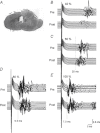Corticospinal reorganization after spinal cord injury
- PMID: 22586214
- PMCID: PMC3476625
- DOI: 10.1113/jphysiol.2012.233189
Corticospinal reorganization after spinal cord injury
Abstract
The corticospinal tract (CST) is a major descending pathway contributing to the control of voluntary movement in mammals. During the last decades anatomical and electrophysiological studies have demonstrated significant reorganization in the CST after spinal cord injury (SCI) in animals and humans. In animal models of SCI, anatomical evidence showed corticospinal sprouts rostral and caudal to the lesion and their integration into intraspinal axonal circuits. Electrophysiological data suggested that indirect connections from the primary motor cortex to forelimb motoneurons, via brainstem nuclei and spinal cord interneurons, or direct connections from slow uninjured corticospinal axons, might contribute to the control of movement after a CST injury. In humans with SCI, post mortem spinal cord tissue revealed anatomical changes in the CST some of which were similar but others markedly different from those found in animal models of SCI. Human electrophysiological studies have provided ample evidence for corticospinal reorganization after SCI that may contribute to functional recovery. Together these studies have revealed a large plastic capacity of the CST after SCI. There is also a limited understanding of the relationship between anatomical and electrophysiological changes in the CST and control of movement after SCI. Increasing our knowledge of the role of CST plasticity in functional restoration after SCI may support the development of more effective repair strategies.
Figures






References
-
- Alexeeva N, Broton JG, Calancie B. Latency of changes in spinal motoneuron excitability evoked by transcranial magnetic brain stimulation in spinal cord injured individuals. Electroencephalogr Clin Neurophysiol. 1998;109:297–303. - PubMed
-
- Alexeeva N, Broton JG, Suys S, Calancie B. Central cord syndrome of cervical spinal cord injury: widespread changes in muscle recruitment studied by voluntary contractions and transcranial magnetic stimulation. Exp Neurol. 1997;148:399–406. - PubMed
-
- Alstermark B, Górska T, Johannisson T, Lundberg A. Effects of dorsal column transection in the upper cervical segments on visually guided forelimb movements. Neurosci Res. 1986;3:462–466. - PubMed
-
- Alstermark B, Isa T, Ohki Y, Saito Y. Disynaptic pyramidal excitation in forelimb motoneurons mediated via C3-C4 propriospinal neurons in the Macaca fuscata. J Neurophysiol. 1999;82:3580–3585. - PubMed
-
- Alstermark B, Ogawa J, Isa T. Lack of monosynaptic corticomotoneuronal EPSPs in rats: disynaptic EPSPs mediated via reticulospinal neurons and polysynaptic EPSPs via segmental interneurons. J Neurophysiol. 2004;91:1832–1839. - PubMed
Publication types
MeSH terms
Grants and funding
LinkOut - more resources
Full Text Sources
Medical

